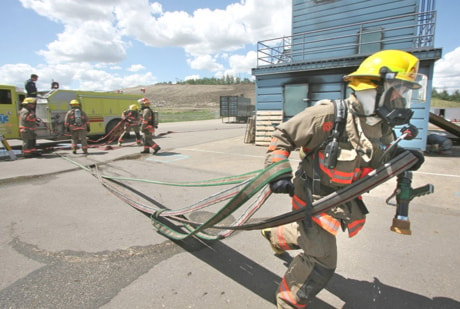The first of Red Deer’s 40 new fire-medics were to receive their crew assignments today.
Some of them will start work on Monday.
It’s been a tough haul and worth every minute of it, says 22-year-old Aaron Wood, formerly of Cranbrook, B.C., and one of 10 recruits to have just completed the Level 1 fire suppression course at the city’s fire training centre.
All 10 of the new recruits are already trained as paramedics. Some of them have field experience and others are fresh out of school, said Mike Godwin, safety officer for the city’s Emergency Services Department.
A few of them already have their Level 1 firefighting certificates. But others, like Wood, are completely new to fire suppression.
For them, the month of June has been a straight-up learning curve, working from 8 a.m. to 6 p.m. every day to learn the basic skills they will need to fulfil their duties as full-fledged fire-medics for the city.
Wood said he is thrilled with the opportunity to work in a fully-integrated system, which was his goal when he enrolled in paramedic training at SAIT.
At the other end of the spectrum is 31-year-old Trevor Stephenson, a former school teacher who took an about-turn and found work as an EMT with the City of Wetaskiwin.
Stephenson is one of four recruits to already have the Level 1 certificate. But there was still lots to learn, he said.
Red Deer has its own set of protocols, the trucks are a little different and some of the skills were a little rusty, said Stephenson.
The goal of this round of training was to get the first 10 recruits on the job, and then hire and train a second group, said Carol Dyck, human resources co-ordinator for the city.
Red Deer is committed to adding 40 new fire-medics to its existing 130 by the end of this year, said Dyck.
It’s an unusual move for the city, which had originally planned to hire much more slowly so new recruits could be more properly integrated into the system, she said.
“When they opened up Station 2 . . . in the early ’80s, we ended up hiring 15 at a time. What we learned from that experience, we’re better off to hire a few at a time and that’s why we hire, usually, five a year for the few years preceding opening up a new hall. That way, they’re better trained and more integrated,” she said.
The city had planned to hire five recruits this year to fulfil staffing needs for Station 5, located at the northwest side of the city.
However, recently the province took over ambulance services and contracted with the City of Red Deer to provide that service, which requires at least five ambulances available on call, 24 hours a day, seven days a week.
The result has been the need for an additional 35 fire-medics, which the city agreed to provide by the end of this year. The additional costs are being covered under the city’s contract with the province, said Dyck.
Fire-medics’ jobs are physically and mentally demanding, and very hard to come by, said Wood.
Even though the field remains highly competitive, the changes at Alberta Health have opened a large number of new opportunities for paramedics and firefighters looking for work, he said.
bkossowan@www.reddeeradvocate.com
